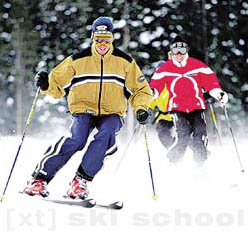|
Downhill Intention: The Countered Position
Remember flying down the slope when you tried to make a turn and ended up in a semi pirouette like a dancer going into a spin? Or the time you tried to ski the moguls and found yourself looking uphill flat on your back? These situations are common and the same mistake is made by every budding expert on their trek to the expert level.
The problem is quite simple to fix. Think again of the headlight progression. Remember the skis are like the tires of your car, as the car is steered into a turn, the headlights don't align with the wheels until the turn is completed. The same is true for the skis and shoulders. The shoulders face downhill until the turn is completed. Then and only then do the skis and shoulders align in the same direction.
Everything moves downhill
Think of everything as moving downhill. The body must be facing downhill. After all, skiers move down the hill -- not up. Face toward the direction of travel or downhill. Think of it like this, the downhill direction is the future - where everyone wants to be - looking about 20 feet ahead. If you looks down at the ski tips, you can only see the snow presently being skied -- you are stuck in the present. further, you can't see what is coming up, hence you have to look to the future. If you get turned around or rotated toward the uphill side, you is looking to the past, this is the most common mistake. Why look back? It's already been done.
Again the hands
The biggest mistake that causes skiers to get twisted up is the hand position. If the uphill hand is dropped to the side, it effectively closes the body off to the downhill side. The uphill hand and body has to be always forward of the downhill hand and body. this is the basic law of body position. The uphill half of the body has to forward of the downhill half.
Twisting the glove
The problem for most comes from not finding the turning power necessary to twist the feet. If you always keep your upper body facing downhill, your feet will have a stationary object to turn against. The rotational force can be best demonstrated by twisting a glove like wringing out a towel. Hold the glove by the top and let the glove untwist itself. Think of the top of the glove as the upper body and the lower part of the glove as the legs. The glove will right itself without having to twist the upper half. The body works on the same principal. The upper half of the body doesn't have to move in order to turn or steer the feet. If the upper body straightens and follows with the turn, the power to turn will be lost. A countered or downhill intention must be maintained in order to deliver the turning power.
The upper body has to be quiet, stable and facing downhill in order to promote a balanced position.The best skiers seem to move over the snow regardless of the terrain because they have mastered this technique. This balanced position comes from keeping a countered position or downhill intention with the upper body. The position of the upper torso also turns the hip in an open position to the downhill side which in turn keeps the feet and skis controlled.
Skiers who tend to rotate the upper body with their turns effectively lose edge engagement, while over steering and skidding their turns. As the body closes to the downhill side or rotates with the turn, the feet will flatten and the ski will lose edge angle. The knees lose their ability to drive inside with as the hip closes. The knees then only have the ability to bend forward, which does nothing for edge engagement.
Alpine Skiing School section in english version of WWW.SKI.BG is based on
"A Guide To Becoming An Expert: From First Time To A Lifetime"
by John Mukavitz Copyright © 1998

|


